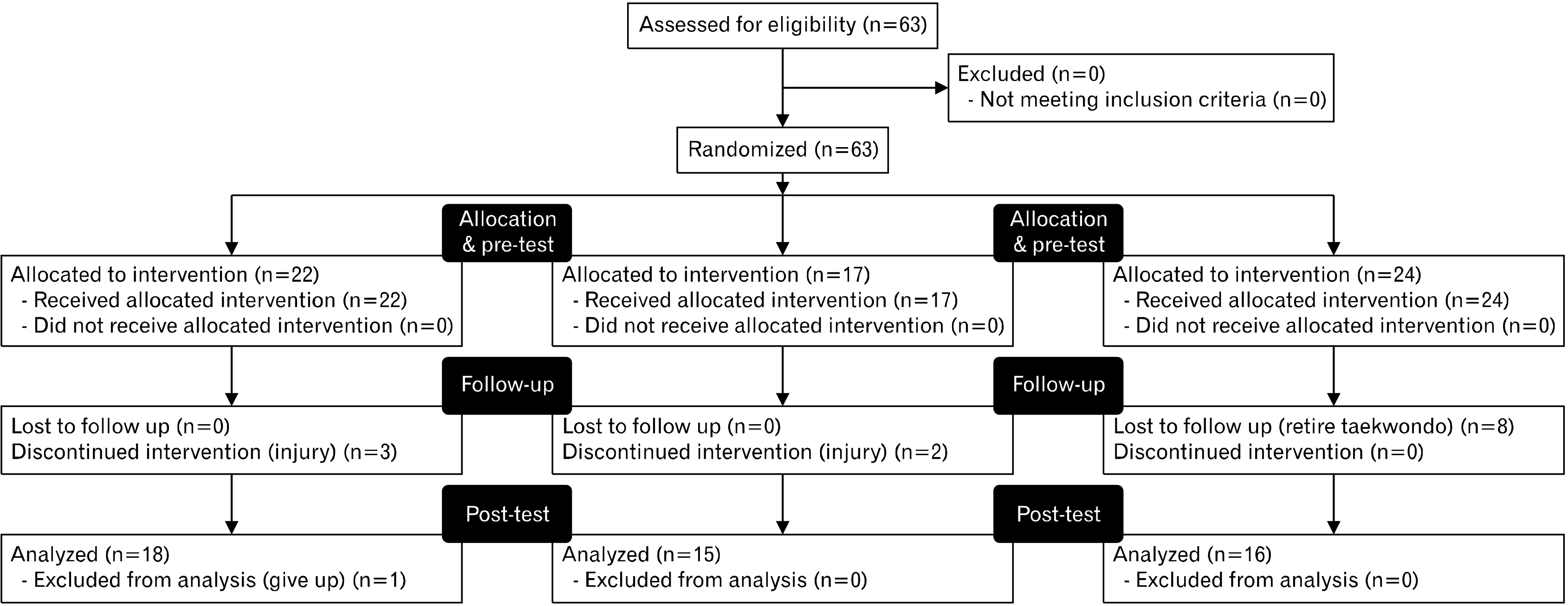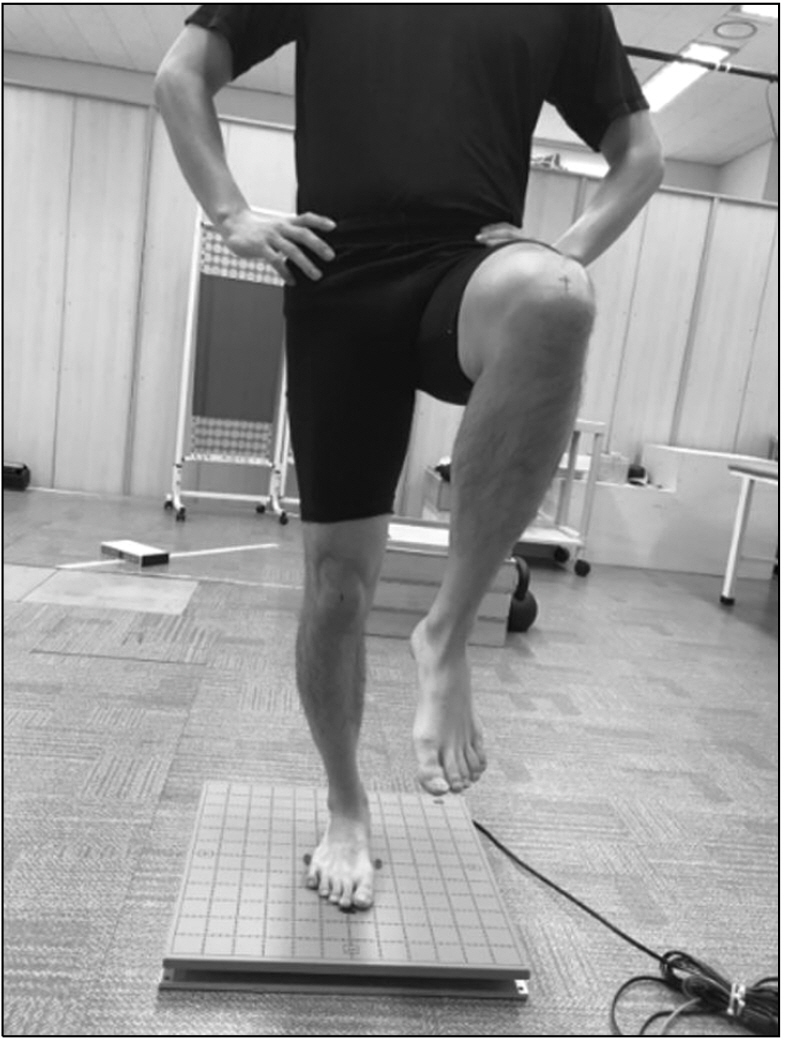Korean J Sports Med.
2023 Jun;41(2):73-82. 10.5763/kjsm.2023.41.2.73.
Effects of 6-Week Dynamic and Static Neuromuscular Training Program on Postural Stability Control of High School Taekwondo Athletes
- Affiliations
-
- 1Department of Physical Education, Yonsei University, Seoul, Korea
- 2International Olympic Committee Research Centre Korea, Seoul, Korea
- 3Department of Sports and Health Management, Mokwon University, Daejeon, Korea
- 4Department of Sports Rehabilitation Medicine, Kyungil University, Gyeongsan, Korea
- 5Institute of Convergence Science, Yonsei University, Seoul, Korea
- KMID: 2542978
- DOI: http://doi.org/10.5763/kjsm.2023.41.2.73
Abstract
- Purpose
This study aimed to compare a dynamic neuromuscular training program with a static neuromuscular training program for taekwondo players.
Methods
This study design was a randomized control trial. Three high school taekwondo teams (taekwondo neuromuscular training [TNT] group, 22; Get Set group, 17; and control group, 24) participated in the study. Get Set group performed a program focused on the static movement, and TNT group performed a program which was modified Get Set to dynamic movement. Control group maintained the existing taekwondo training without any intervention. The intervention group performed 15-minute training three times a week for 6 weeks. Dynamic Postural Stability Index (DPSI) and time-to-boundary test (TTB) tests were performed before and after 6 weeks of training.
Results
As a result of DPSI, an interaction effect was observed only in the anterior/posterior stability index of the dominant leg of the TNT and Get Set groups (p<0.05). However, there was no difference between the TNT and the Get Set groups. As a result of TTB analysis, no statistical effect was observed in all variables of the dominant and non-dominant legs.
Conclusion
As a result of conducting 6-week dynamic and static neuromuscular training for taekwondo athletes, the effect of training was found in both the intervention group. However, differences in training effects between groups could not be proved. Therefore, it is necessary to clearly confirm the difference between the two training through long-term follow-up studies.
Keyword
Figure
Reference
-
1. Lystad RP, Pollard H, Graham PL. 2009; Epidemiology of injuries in competition taekwondo: a meta-analysis of observational studies. J Sci Med Sport. 12:614–21. DOI: 10.1016/j.jsams.2008.09.013. PMID: 19054714.
Article2. Jeong HS, Ha S, Lee SY. 2020; Injuries of Korean youth taekwondo athletes applying injury surveillance systems. J Sport Leis Stud. 82:433–440. DOI: 10.51979/KSSLS.2020.10.82.433.
Article3. Thomas RE, Thomas BC, Vaska MM. 2017; Injuries in taekwando: systematic review. Phys Sportsmed. 45:372–90. DOI: 10.1080/00913847.2017.1369193. PMID: 28829198.
Article4. McCall A, Carling C, Nedelec M, et al. 2014; Risk factors, testing and preventative strategies for non-contact injuries in professional football: current perceptions and practices of 44 teams from various premier leagues. Br J Sports Med. 48:1352–7. DOI: 10.1136/bjsports-2014-093439. PMID: 24837243.
Article5. Alentorn-Geli E, Myer GD, Silvers HJ, et al. 2009; Prevention of non-contact anterior cruciate ligament injuries in soccer players. Part 2: a review of prevention programs aimed to modify risk factors and to reduce injury rates. Knee Surg Sports Traumatol Arthrosc. 17:859–79. DOI: 10.1007/s00167-009-0823-z. PMID: 19506834.
Article6. Hübscher M, Zech A, Pfeifer K, Hänsel F, Vogt L, Banzer W. 2010; Neuromuscular training for sports injury prevention: a systematic review. Med Sci Sports Exerc. 42:413–21. DOI: 10.1249/MSS.0b013e3181b88d37.7. Emery CA, Cassidy JD, Klassen TP, Rosychuk RJ, Rowe BH. 2005; Effectiveness of a home-based balance-training program in reducing sports-related injuries among healthy adolescents: a cluster randomized controlled trial. CMAJ. 172:749–54. DOI: 10.1503/cmaj.1040805. PMID: 15767608. PMCID: PMC552888.
Article8. Rivera MJ, Winkelmann ZK, Powden CJ, Games KE. 2017; Proprioceptive training for the prevention of ankle sprains: an evidence-based review. J Athl Train. 52:1065–7. DOI: 10.4085/1062-6050-52.11.16. PMID: 29140127. PMCID: PMC5737043.
Article9. Sañudo B, Sánchez-Hernández J, Bernardo-Filho M, Abdi E, Taiar R, Núñez J. 2019; Integrative neuromuscular training in young athletes, injury prevention, and performance optimization: a systematic review. Appl Sci. 9:3839. DOI: 10.3390/app9183839.
Article10. Butler RJ, Lehr ME, Fink ML, Kiesel KB, Plisky PJ. 2013; Dynamic balance performance and noncontact lower extremity injury in college football players: an initial study. Sports Health. 5:417–22. DOI: 10.1177/1941738113498703. PMID: 24427412. PMCID: PMC3752196.
Article11. Yoo S, Park SK, Yoon S, Lim HS, Ryu J. 2018; Comparison of proprioceptive training and muscular strength training to improve balance ability of taekwondo poomsae athletes: a randomized controlled trials. J Sports Sci Med. 17:445–54.12. İpekoğlu G, Erdogan CS, ER F, Baltaci G, Colakoglu FF. 2018; Effect of 12 week neuromuscular weighted rope jump training on lower extremity reaction time. Turk J Sport Exerc. 20:111–5.
Article13. Verhagen E. 2015; Get Set: prevent sports injuries with exercise! Br J Sports Med. 49:762. DOI: 10.1136/bjsports-2015-094644.14. Giboin LS, Gruber M, Kramer A. 2015; Task-specificity of balance training. Hum Mov Sci. 44:22–31. DOI: 10.1016/j.humov.2015.08.012. PMID: 26298214.15. Patti A, Messina G, Palma R, et al. 2018; Comparison of posturographic parameters between young taekwondo and tennis athletes. J Phys Ther Sci. 30:1052–5. DOI: 10.1589/jpts.30.1052. PMID: 30154599. PMCID: PMC6110219.
Article16. Wikstrom EA, Tillman MD, Smith AN, Borsa PA. 2005; A new force-plate technology measure of dynamic postural stability: the dynamic postural stability index. J Athl Train. 40:305–9.17. Huurnink A, Fransz DP, Kingma I, de Boode VA, Dieën JH. 2019; The assessment of single-leg drop jump landing performance by means of ground reaction forces: a methodological study. Gait Posture. 73:80–5. DOI: 10.1016/j.gaitpost.2019.06.015. PMID: 31302336.
Article18. Hertel J, Olmsted-Kramer LC, Challis JH. 2006; Time-to-boundary measures of postural control during single leg quiet standing. J Appl Biomech. 22:67–73. DOI: 10.1123/jab.22.1.67. PMID: 16760569.
Article19. Pau M, Porta M, Arippa F, et al. 2019; Dynamic postural stability, is associated with competitive level, in youth league soccer players. Phys Ther Sport. 35:36–41. DOI: 10.1016/j.ptsp.2018.11.002. PMID: 30419410.
Article20. Räisänen AM, Galarneau JM, van den Berg C, et al. 2022; Identifying predictors of response and non-response to neuromuscular training warm-up programs among youth. Osteoarthr Cartil. 30:S234. DOI: 10.1016/j.joca.2022.02.317.21. Paillard T, Noé F. 2020; Does monopedal postural balance differ between the dominant leg and the non-dominant leg?: a review. Hum Mov Sci. 74:102686. DOI: 10.1016/j.humov.2020.102686. PMID: 33059226.
Article22. Myer GD, Ford KR, Brent JL, Hewett TE. 2006; The effects of plyometric vs. dynamic stabilization and balance training on power, balance, and landing force in female athletes. J Strength Cond Res. 20:345–53. DOI: 10.1519/00124278-200605000-00019. PMID: 16686562.
Article23. Paterno MV, Myer GD, Ford KR, Hewett TE. 2004; Neuromuscular training improves single-limb stability in young female athletes. J Orthop Sports Phys Ther. 34:305–16. DOI: 10.2519/jospt.2004.34.6.305. PMID: 15233392.
Article24. Bešlija T, Marinković D, Čular D. 2017; Postural stability assessment in elite taekwondo athletes: comparative study between different age group. Acta Kinesiol. 11:98–104.25. Ha CS, Yoon JS, Kim JJ. 2011; The biomechanical analysis of the taekwondo in dollyochagi motion during the badachagi. Korean J Sport Sci. 20:1187–95.26. McKeon PO, Ingersoll CD, Kerrigan DC, Saliba E, Bennett BC, Hertel J. 2008; Balance training improves function and postural control in those with chronic ankle instability. Med Sci Sports Exerc. 40:1810–9. DOI: 10.1249/MSS.0b013e31817e0f92. PMID: 18799992.
Article27. Motealleh A, Mohamadi M, Moghadam MB, Nejati N, Arjang N, Ebrahimi N. 2019; Effects of core neuromuscular training on pain, balance, and functional performance in women with patellofemoral pain syndrome: a clinical trial. J Chiropr Med. 18:9–18. DOI: 10.1016/j.jcm.2018.07.006. PMID: 31193229. PMCID: PMC6522640.
Article28. Surakhamhaeng A, Bovonsunthonchai S, Vachalathiti R. 2020; Effects of balance and plyometric training on balance control among individuals with functional ankle instability. Physiother Q. 28:38–45. DOI: 10.5114/pq.2020.92474.29. Singh A, Boyat AV, Sandhu JS. 2015; Effect of a 6 week plyometric training program on agility, vertical jump height and peak torque ratio of Indian taekwondo players. Sport Exerc Med Open J. 1:42–6. DOI: 10.17140/SEMOJ-1-107.
Article30. Freyler K, Krause A, Gollhofer A, Ritzmann R. 2016; Specific stimuli induce specific adaptations: sensorimotor training vs. reactive balance training. PLoS One. 11:e0167557. DOI: 10.1371/journal.pone.0167557. PMID: 27911944. PMCID: PMC5135127.
Article
- Full Text Links
- Actions
-
Cited
- CITED
-
- Close
- Share
- Similar articles
-
- The Circadian Effects on Postural Stability in Young Adults
- Effects of Acute Low Back Pain on Postural Control
- Effects of Sitting Balance Using Visuo-perceptual Biofeedback Training in Stroke Patients
- Successful Treatment of Anterior Knee Impingement Syndrome in Taekwondo Athletes
- Visual Biofeedback Balance Training Using COBETS





